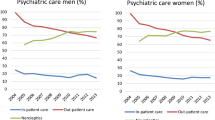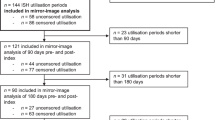Abstract
Introduction
Reorganization of psychiatric treatment in Denmark involved a declining number of psychiatric long-stay beds and an increasing number of psychiatric supported housing facilities in the community. Very few studies have focused on the population in such facilities.
Methods
Information was generated combining addresses of supported psychiatric housing facilities with information from the Danish Civil Registration System to create a case register of persons living in supported psychiatric housing facilities. Through linkage with the Danish Psychiatric Central Register, we examined predictors of becoming a resident in a psychiatric housing facility, use of psychiatric services around the time of entrance to a supported psychiatric housing facility, and mortality rates for residents in a psychiatric housing facility compared to non-residents and to persons in the general population who never experienced a psychiatric admission.
Results
We identified schizophrenia as the strongest diagnostic predictor of becoming a resident in a supported psychiatric housing facility, followed by organic mental disorders, substance abuse, and affective disorder. In addition, the higher the number of psychiatric bed days, the higher the risk. Compared to the years before the first entrance to a supported psychiatric housing facility, the number of bed days in the year following the first entrance dropped more among residents than among comparable psychiatric patients. Mortality rates were slightly higher among residents in a supported psychiatric housing facility than among comparable psychiatric patients, but more than tenfold higher when compared to the general population of Danes.
Conclusion
The vast majority of persons who became residents in supported psychiatric housing facilities had previously been diagnosed with schizophrenia, schizophrenia-like disorders, and organic mental disorders, and a large proportion had substance abuse and a high use of bed days. Moving into such a facility reduced the number of bed days.

Similar content being viewed by others
References
Priebe S, Badesconyi A, Fioritti A, Hansson L, Kilian R, Torres-Gonzales F et al (2005) Reinstitutionalisation in mental health care: comparison of data on service provision from six European countries. Br Med J 330:123–126
Leff J, Trieman N (2000) Long-stay patients discharged from psychiatric hospitals. Social and clinical outcomes after five years in the community. The TAPS Project 46. Br J Psychiatry 176:217–223
Priebe S, Saidi M, Want A, Mangalore R, Knapp M (2009) Housing services for people with mental disorders in England: patient characteristics, care provision and costs. Soc Psychiatry Psychiatr Epidemiol 44:805–814
Macpherson R, Edwards TR, Chilvers R, David C, Elliott HJ (2009) Twenty-four hour care for schizophrenia. Cochrane Database Syst Rev 2009:CD004409
Pedersen CB, Gotzsche H, Moller JO, Mortensen PB (2006) The Danish Civil Registration System. A cohort of eight million persons. Dan Med Bull 53:441–449
Mors O, Perto GP, Mortensen PB (2011) The Danish psychiatric central research register. Scand J Public Health 39:54–57
World Health Organization (1992) The ICD-10 Classification of mental and behavioural disorders. Clinical descriptions and diagnostic guidelines. WHO, Geneva
Breslow NE, Day NE (1980) Statistical methods in cancer research. 1. The analysis of case-control studies. International Agency for Research on Cancer, Lyon
SAS Institute Inc (2004) The PhReg procedure. SAS/STAT 9.1 User’s Guide. SAS Institute Inc., Cary, pp 3213–3332
Marshall M, Lockwood A (2003) Assertive Community Treatment for people with severe mental disorders. Cochrane Libr 2003:5
Burns T, Catty J, Dash M, Roberts C, Lockwood A, Marshall M (2007) Use of intensive case management to reduce time in hospital in people with severe mental illness: systematic review and meta-regression. Br Med J 335:336
Bertelsen M, Jeppesen P, Petersen L, Thorup A, Ohlenschlaeger J, le QP et al (2008) Five-year follow-up of a randomized multicenter trial of intensive early intervention vs standard treatment for patients with a first episode of psychotic illness: the OPUS trial. Arch Gen Psychiatry 65:762–771
Wahlbeck K, Westman J, Nordentoft M, Gissler M, Laursen TM (2011) Outcomes of Nordic mental health systems: life expectancy of patients with mental disorders. Br J Psychiatry (epub ahead of print)
Andrews AO, Bartels SJ, Xie H, Peacock WJ (2009) Increased risk of nursing home admission among middle aged and older adults with schizophrenia. Am J Geriatr Psychiatry 17:697–705
Uggerby P, Nielsen RE, Correll CU, Nielsen J (2011) Characteristics and predictors of long-term institutionalization in patients with schizophrenia. Schizophr Res 131:120–126
Caplan B, Schutt RK, Turner WM, Goldfinger SM, Seidman LJ (2006) Change in neurocognition by housing type and substance abuse among formerly homeless seriously mentally ill persons. Schizophr Res 83:77–86
Fakhoury WK, Priebe S, Quraishi M (2005) Goals of new long-stay patients in supported housing: a UK study. Int J Soc Psychiatry 51:45–54
Pedersen CB (2009) Urban-rural differences in the risk of schizophrenia. 2009. University of Aarhus: Faculty of Health Sciences. Thesis/Dissertation
Author information
Authors and Affiliations
Corresponding author
Rights and permissions
About this article
Cite this article
Nordentoft, M., Pedersen, M.G., Pedersen, C.B. et al. The new asylums in the community: severely ill psychiatric patients living in psychiatric supported housing facilities. A Danish register-based study of prognostic factors, use of psychiatric services, and mortality. Soc Psychiatry Psychiatr Epidemiol 47, 1251–1261 (2012). https://doi.org/10.1007/s00127-011-0432-2
Received:
Accepted:
Published:
Issue Date:
DOI: https://doi.org/10.1007/s00127-011-0432-2




